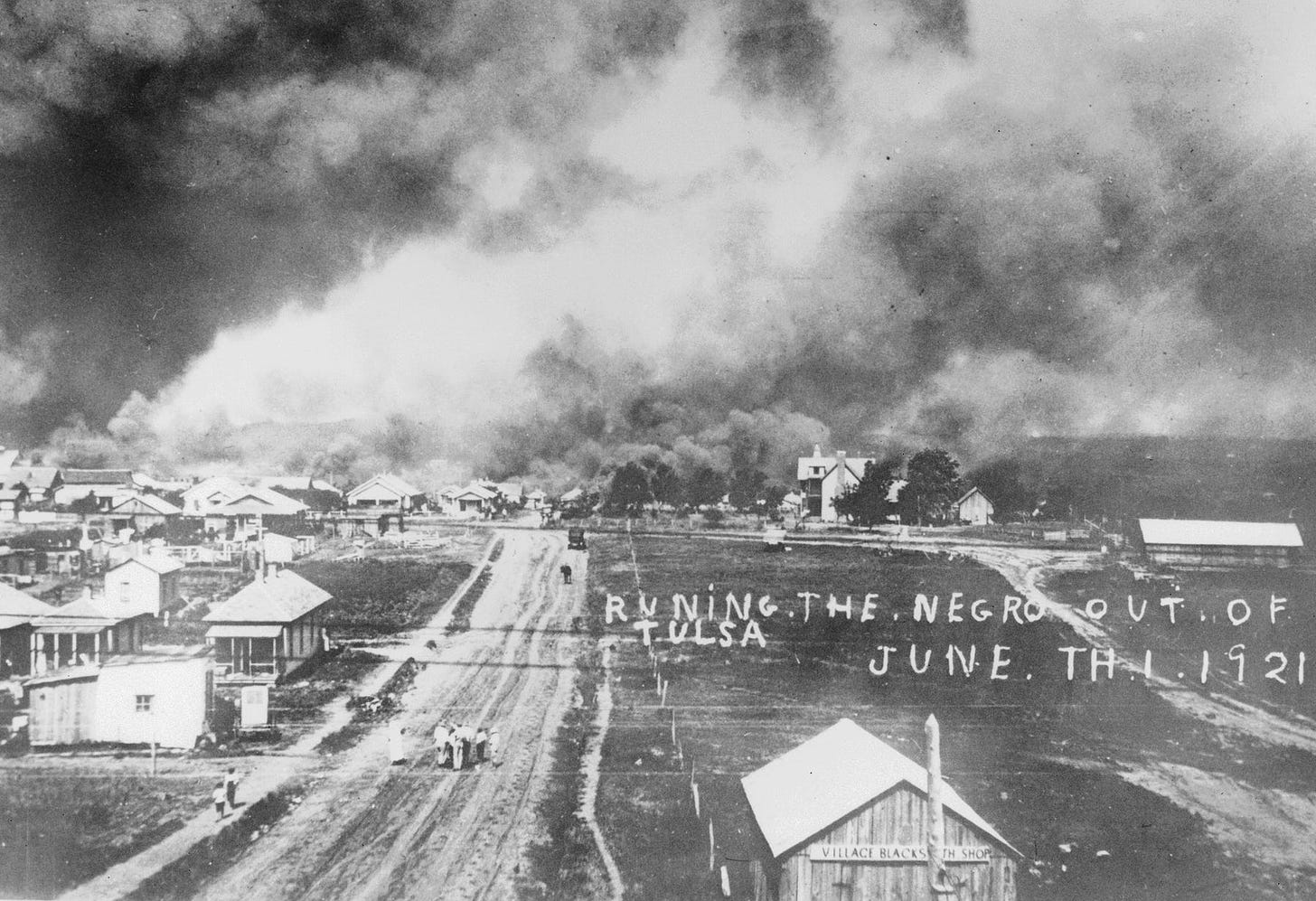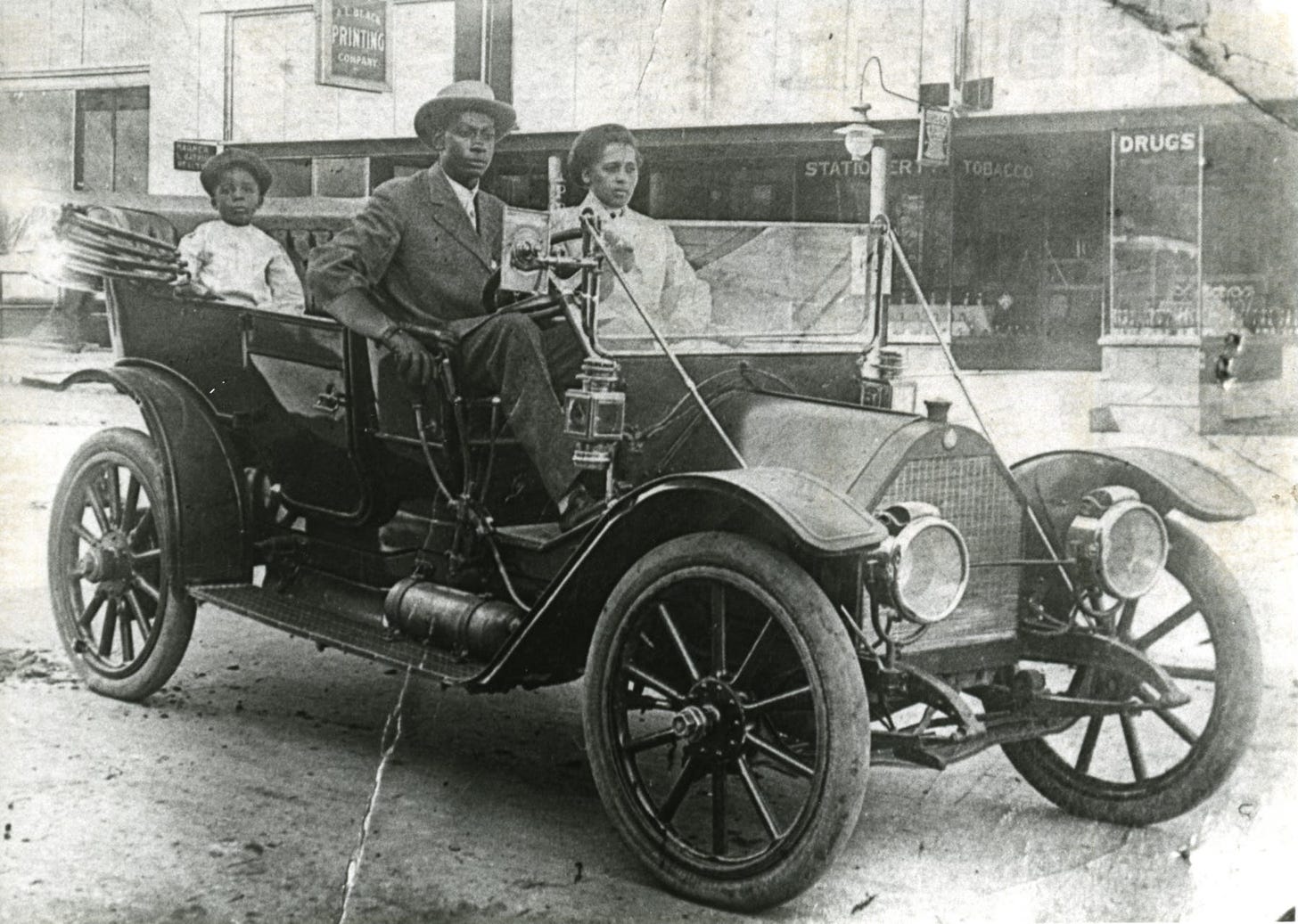Ricochet is the best place on the internet to discuss the issues of the day, either through commenting on posts or writing your own for our active and dynamic community in a fully moderated environment. In addition, the Ricochet Audio Network offers over 50 original podcasts with new episodes released every day.
 Better Late Than Never: Learning About the Tulsa Race Massacre
Better Late Than Never: Learning About the Tulsa Race Massacre
I love my home state of Oklahoma. It is home to wonderful people; family, friends, excellent schools, a terrific and diverse culture, and some remarkable history.
Attending public schools during my formative years, from kindergarten in Guymon to college in Chickasha, I took my share of Oklahoma history classes and remember much of it today. In college, my Oklahoma history class taught me about President Andrew Jackson’s forced relocation of Indian tribes from the southeast to Oklahoma Indian Territory — the “Trail of Tears.” Thousands died.
My high school classes at Washington High School (McClain County) and US Grant High School in Oklahoma City taught us about post-Civil War land runs of the late 19th century, including one that attracted my ancestors from Missouri. Little was taught about Indian territory’s role during the Civil War (most Indian tribes employed slaves and fought for the Confederacy). Oklahoma’s path to statehood in 1906 was something I learned about in third grade. And our very colorful politics and politicians – one never stops learning about them since they’re constantly making their presence known. Oklahoma was one of the last states to ban cockfighting (2002) and legalize “liquor by the drink” (1984).
Oklahoma was a predominantly Democratic state until they elected their first GOP Governor, Henry Bellmon, in 1962. Its politics have always had a populist flair. But I digress.

Little, if anything, was taught about the Tulsa race massacre of 1921, exactly 100 years ago this week, that destroyed the predominantly black community anchored by the intersection of Greenwood and Archer Streets. Nor did I ever, as a news reporter and editor in Oklahoma after college graduation, ever write about it. The black community there was vibrant, even prosperous, and home to what was then called “Black Wall Street.” Then, on May 30th and June 1st, a racially motivated white mob torched and destroyed; much of it went up in smoke as hundreds of homes and businesses lied in ruins. Several hundred died. And they’re still finding mass gravesites.
But I’m incredibly embarrassed that it has taken this long for many of us to catch up to this horrible violent racism. The Ku Klux Klan, then the terrorist wing of the Democratic Party, was riding high during the height of the horrific “Jim Crow” era. Systemic racism was real then and out in the open for all to see then, not just in Tulsa. After all, we’d just completed eight years of, arguably, our nation’s most racist President, Woodrow Wilson, a eugenicist who segregated the US military (Harry Truman would reverse that a quarter-century later), and more.
The Daily Oklahoman and Tulsa World have done yeoman’s work to tell the whole story, in context belatedly. And there are finally some terrific books on the 1921 tragedy, including “The Burning” by Tim Madigan.

While many media now publish stories about the race massacre, some seem polluted more by modern narratives than straight, honest, and even brutal if belated historical reporting. I am grateful to my home state’s two leading newspapers for helping us all make up for the lost time.
I continue to fear that politically motivated charlatans will use this occasion to drive harmful narratives and justify terrible policy proposals. Thus are the times. However, it is always valuable to honestly investigate and learn from these painful, horrible episodes so that they never happen again. It is better than removing monuments and trying to erase history.
Published in General



I learned about the Tulsa race riots from the HBO Watchmen sequel series. I understood the allusion to the Tuskegee syphilis trials in the Captain America series Truth: Red, White, and Black. I can’t remember the book, but I learned about the Red Summer riots from a comic book too. As least for these instances, pop culture, not the classroom, was my first exposure to these chapters in history. Not sure if this is an indictment of my education or justification for my graphic novel consumption…
I never heard of it till this year. I am shocked by the enormity of it, and very disturbed by the failure of schools to teach it.
The accounts of the Tulsa mob-led killings and destruction provide an insight on a question I have long pondered: why have not Americans of black descent come together in local communities, and established mutual aid societies, and local financial insitutions, so as to help members of their comminuity rise, as so many other ethnic groups have done? Germans, Irish, Italians —
Well, it appears that while Bostonians had their “No Irish need apply” posters in their business’ windows, they were not forming mobs to destroy entire enclaves, like the riots and mob actions in Tulsa. My grandmother (b. in Germany, arrived here at age 9) told me of the family’s fears of discrimination or worse during WWI, as anti-German propaganda was rampant (and they had a German last name, the kids spoke German at home, etc.) but no hostile actions were ever inflicted upon them.
So perhaps part of the answer to my question is, when blacks did come together to foster their own prosperity, such as in early 20th-C. Tulsa, they were ruthlessly pulled down, crimes excused by the racism of the times, and the failure of the country’s promise of equal treatment under the law.
Thank you for a very enlightening article and references.
Fellow Okie here. I grew up in Canadian County. We were taught almost nothing about it, just a mention every year.
I think you may be right. I been thinking lately that the most shameful period in America’s history is not the slavery period. It was brutal and awful, but slavery has existed throughout human history and it was established here before we became a nation. But what happened after the Civil War, from Jim Crow to atrocities such as the Tulsa race riots, cannot be blamed on what we inherited from our European roots. No, that was squarely on America (mostly Democrats) and it was a disgrace. When one reads this other history, the one we were not taught, we understand much better the historical mistrust in much of the black community.
Wonderful post and question. In reality, many in the black community in Tulsa did come together and aid each other after that horrific event in 1921. And they still are. The Daily Oklahoman and especially the Tulsa World links outline some of that. The community did rebuild, but not entirely, and the process continues today, thwarted by other development projects (new freeways, etc.).
I heard about this over 30 years ago though not in school at any level. I may have read it or listened on an NPR broadcast. I can’t remember the specific specific event that started it.
I did see this today and it makes me think things will not end well.
There was an episode of Tony Brown’s Journal some years ago (2000? 2001?) that covered the Tulsa Race Riot. If I recall, Brown was the first television journalist to address the Tulsa Riot in detail. From that and other sources I’ve consulted, it seems clear that the event was a damned tragic explosion of evil and race hatred which set race relations in that part of the country back 30 years, at least, undoing much of the progress that had been made in the Reconstruction Era and into the 1910s.
Here’s a four-minute except from the episode I found on Youtube.
Embrace the power of “both/and”.
Thanks for posting as I think I was only passingly aware; I was more familiar with the Rosewood incident
https://www.youtube.com/watch?v=MhTg98WzH5U
Unusual in that the white rioters in Tulsa were likely poorer per capita than the blacks attacked.
The KKK was making a revival at that time probably because non-WASP immigrants seemed to be overwhelming the country. (ASIDE: My grandfather,who grew up moving westward as his contractor-father build railroads, told me that the only reason that anti-Irish Catholic prejudice subsided was the arrival of even more foreign-seeming ethnics: “All of a sudden we Irish started looking pretty good to the Yankees when the Italians, Poles and Jews started getting off the boat.”)
The whole world seemed to be in a state of disruption after WWI and a prosperous black neighborhood must have seemed like the last straw for some. Large eastern cities (NYC metro area was probably 25% of the US population then) did not much care about news from OK. Even if it had been reported heavily, I think that the Tulsa atrocity would just confirm the existing perception that that sort of thing must have been common in redneck backwaters and thus not really news and certainly not consistent with the melting pot self-image of America preferred in the cities where that was actually the case to a large extent.
It is hard for young people to imagine a world without social media or cable news such that large bad events could pass unnoticed by most people. Persecutions from Armenians to Zhuang never got a film crew.
I’m reminded of the line in Blazing Saddles that ends with “… but not the Irish”. I think old Mel, Richard Pryor and the rest of the writers were onto something back then.